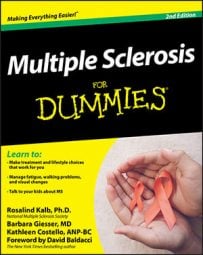When seeking relief for primary or secondary pain symptoms of multiple sclerosis (MS), the key is to find the right medication, taken at the right level, that provides the most relief without causing too much sleepiness or any other unpleasant side effects. Your neurologist may recommend lower doses of more than one medication at a time in order to maximize effectiveness while minimizing side effects.
Common MS pain medications
Even though no medications have been specifically approved for the treatment of MS pain, wide varieties have been used with some success:
Antiseizure medications, including Tegretol (carbamazepine) and Neurontin (gabapentin) are commonly used to treat trigeminal neuralgia and dysesthesias.
Lyrica (pregabalin) is FDA-approved to treat neuropathic pain from diabetes and is currently being studied in MS.
Cymbalta (duloxetine hydrochloride) is FDA-approved for the treatment of depression and for neuropathic pain caused by diabetes. It has been used successfully for MS-related pain as well, particularly dysesthesias.
Tricyclic antidepressants, including Elavil (amitriptyline), Norpramine (desipramine), and Pamelor (nortriptyline), are also helpful with dysesthesias.
For trigeminal neuralgia that doesn’t respond to any of the medications, the doctor may recommend a surgical procedure called a percutaneous rhizotomy. Although the procedure can be done in a variety of ways, the common goal is to deactivate the trigeminal nerve sufficiently to block the sensation of pain.
Significant pain may also accompany certain symptoms of your MS. For example, the muscle stiffness (spasticity) that’s so common in MS can cause extremely painful spasms. These spasms can be managed with the antispasticity medications baclofen and Zanaflex (tizanidine). Valium (diazepam) can be particularly helpful for painful nighttime spasms in the legs and feet. Optic neuritis may be accompanied by severe eye pain that generally responds to a short course of high-dose intravenous corticosteroids.
MS and pain relief: Alternative treatments
Although medications of various types can be extremely useful for managing your pain, you can also consider other alternative options. Acupuncture, for instance, may be helpful for some types of pain (however, it hasn’t be studied extensively in MS). Some people find meditation and other relaxation strategies to be beneficial as well.
Primary pain doesn’t respond to the standard pain medications used for injuries, such as aspirin, Tylenol (acetaminophen), or the various formulations of ibuprofen (Motrin or Advil), because the source of the pain is different. Primary pain also doesn’t respond well to narcotics.
MS and cannabinoids: Deriving benefits from marijuana
Cannabinoids are chemical derivatives of marijuana plants. Recent research efforts have focused on trying to capture the benefits of cannabinoids for various problems, including neuropathic pain and spasticity, while minimizing the side effects and health risks associated with smoked marijuana.
Sativex, an oromucosal spray (which means that it’s sprayed into the mouth and absorbed through the mucous membrane) developed from marijuana extracts by GW Pharmaceuticals, is now approved in Canada for the treatment of MS-related pain and in Canada, the United Kingdom, Spain, and the Czech Republic for the treatment of spasticity.
The company hasn’t yet applied to the U.S. Food and Drug administration for approval, but it has been given the go-ahead by the FDA to test the drug in the United States. For more information about the issues surrounding the use of marijuana and its derivatives for treatment of MS symptoms, take a look at the National MS Society’s information about marijuana.

